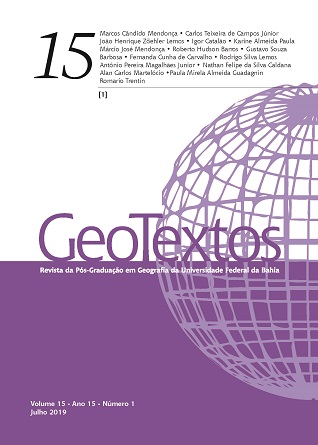MATA MERIDIONAL PERNAMBUCANA AND UNDERDEVELOPMENT: AN APPROACH THROUGH THE CELSO FURTADO’S THEORY
DOI:
https://doi.org/10.9771/geo.v15i1.29186Keywords:
Center-periphery, Underdevelopment, Mata Meridional PernambucanaAbstract
In the twentieth century the economic debates turned mainly to the classical theories to explain the process of development of the nations, and there is a gap regarding the specific reflection on countries and peripheral regions. Faced with the inability to explain the underdevelopment of these areas, Furtado, among other economists, began to evaluate the persistence of underdevelopment as a historical-structural trait of the formation of peripheral economies. In this context, the Mata Meridional Pernambucana, constituted since the colonial period from the sugar cane industry and which at present maintains patterns of underdevelopment typical. Taking as a hypothesis the validity of Furtado’s reflections for the understanding of microregional underdevelopment and from bibliographical research and data collection, the present text has as general objective to evaluate the pertinence of the theory developed by Furtado in the analysis of the framework of underdevelopment of the Microregion today. Specific objectives are related to the development of central and peripheral economies; describe the process of underdevelopment and; identify socioeconomic elements that characterize the Microregion today. Through the local historical-structural characteristics, it is concluded that the reflections generated by the author are applicable to the understanding of the permanent, but not unalterable, of microregional’s underdevelopment.Downloads
Downloads
Published
How to Cite
Issue
Section
License
Autores que publicam nesta revista concordam com os seguintes termos:
Autores mantém os direitos autorais e concedem à revista o direito de primeira publicação, com o artigo simultaneamente licenciado sob a Licença Creative Commons Creative Commons CC BY que permite o compartilhamento do trabalho com reconhecimento da autoria e publicação inicial nesta revista. Esta licença permite que outros distribuam, remixem, adaptem e criem a partir do seu trabalho, mesmo para fins comerciais, desde que lhe atribuam o devido crédito pela criação original. É a licença mais flexível de todas as licenças disponíveis. É recomendada para maximizar a disseminação e uso dos materiais licenciados. Ver o resumo da licença em: https://creativecommons.org/licenses/by/4.0/ Ver o texto legal da licença em: https://creativecommons.org/licenses/by/4.0/ Consulte o site do Creative Commons: https://creativecommons.org/licenses/?lang=pt
Autores têm autorização para assumir contratos adicionais separadamente, para distribuição não-exclusiva da versão do trabalho publicada nesta revista (ex.: publicar em repositório institucional ou como capítulo de livro), com reconhecimento de autoria e publicação inicial nesta revista.
Autores têm permissão e são estimulados a publicar e distribuir seu trabalho online (ex.: em repositórios institucionais ou na sua página pessoal) a qualquer ponto antes ou durante o processo editorial, já que isso pode gerar alterações produtivas, bem como aumentar o impacto e a citação do trabalho publicado (Veja O Efeito do Acesso Livre).






